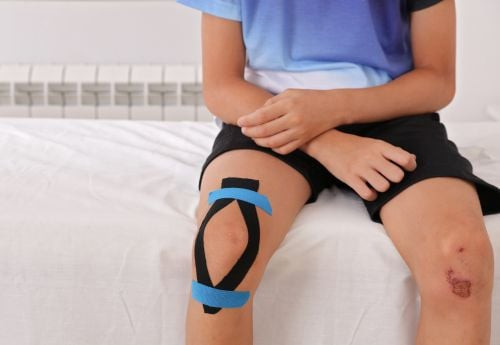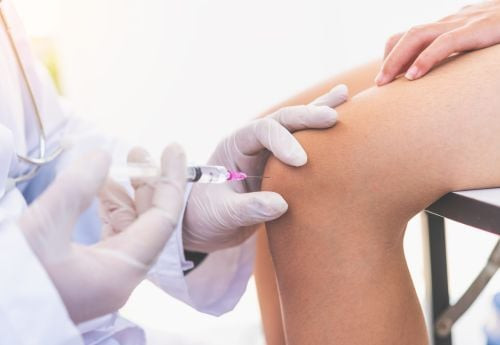Are you passionate about football and medicine? Do you dream of combining your love for the sport with a fulfilling medical career? This article provides a comprehensive guide on How To Become A Football Doctor, also known as a sports medicine physician. Learn about the necessary education, training, salary expectations, and career prospects. CAUHOI2025.UK.COM provides reliable career guidance to help you make informed decisions. This career integrates sports, medicine, athletic care and musculoskeletal expertise.
1. What is a Football Doctor (Sports Medicine Physician)?
Sports medicine physicians, or football doctors, are medical professionals who specialize in treating injuries and illnesses related to physical activity. They focus on the musculoskeletal system, which includes bones, muscles, joints, tendons, and ligaments. According to the American Medical Society for Sports Medicine (AMSSM), these physicians work with both athletes and non-athletes who experience injuries from active lifestyles or sports participation.
To become a football doctor, one must earn a Doctor of Medicine (MD) or Doctor of Osteopathic Medicine (DO) degree. After earning the medical degree, aspiring sports medicine physicians will complete a residency program in a primary care field and undertake a fellowship in sports medicine.
Football doctors can work in various settings, including:
- Colleges and universities
- Hospitals
- Clinics
- Professional sports teams
- Private practices
They often lead medical teams that may include coaches, physical therapists, athletic trainers, and orthopedic surgeons. The responsibilities of a football doctor range from diagnosing ailments and making treatment recommendations to referring patients to specialists such as orthopedic surgeons. They work with amateur, student and professional athletes.
2. What Does a Football Doctor Do?
Football doctors provide non-surgical treatments for sports-related illnesses and musculoskeletal injuries. When surgery is necessary, they collaborate closely with orthopedic surgeons. Their responsibilities extend beyond treatment to include guiding athletes, coaches, and parents on optimal workout routines and injury prevention.
Some common duties of a football doctor include:
- Providing medical attention at athletic events (games, practices, training sessions).
- Identifying and treating sports-related illnesses and injuries.
- Educating athletes and non-athletes on injury prevention and health maintenance.
- Determining when athletes can safely return to play after an injury.
- Offering dietary advice to clients.
- Communicating with coaches and trainers regarding athletes’ medical conditions and recovery progress.
According to a study by the National Institutes of Health (NIH), effective communication between sports medicine physicians, athletes, and coaching staff is essential for successful injury management and prevention.
3. Sports Medicine Education and Training Requirements
The path to becoming a football doctor is lengthy and requires at least 12 years of post-high school education. Here’s a step-by-step guide:
3.1. Earn a Bachelor’s Degree
The first step is to complete a four-year undergraduate program. Medical schools don’t typically require specific majors, but common choices include biology, chemistry, and pre-medicine. Students often take courses in math, chemistry, biology, literature, and other subjects as part of their pre-medical education.
During this time, students should also prepare for the Medical College Admission Test (MCAT). According to the Association of American Medical Colleges (AAMC), strong performance on the MCAT is crucial for gaining admission to medical school.
3.2. Complete Medical School
The next step is attending and completing medical school, which awards either a Doctor of Medicine (MD) or a Doctor of Osteopathic Medicine (DO) degree. In the first two years, students study human anatomy and physiology, pharmacology, patient care, and medical ethics. The final two years are spent in clinical rotations in hospital settings, where students gain experience in patient care, communication, medical record keeping, and teamwork.
3.3. Obtain a Medical License
After graduating from medical school, aspiring football doctors must apply for a temporary medical license. States typically require doctors to hold a license to practice medicine legally. After completing residency and fellowship, physicians will apply for a full medical license to practice sports medicine.
3.4. Complete a Residency
Newly graduated doctors must complete a residency, which involves hands-on training. This typically lasts three to four years. Aspiring football doctors can choose from several residency options, including:
- Family medicine
- Emergency medicine
- Physical medicine and rehabilitation (PM&R)
- Pediatrics
- Orthopedic surgery
- Internal medicine
These residencies provide a strong foundation in medicine before specializing in sports medicine.
3.5. Enroll in a Fellowship
Physicians interested in sports medicine will complete a one- to two-year fellowship in sports medicine after their residency. During the fellowship, they gain in-depth knowledge of sports injuries while working as team doctors for high school or college sports teams. They learn to treat sprains, strains, broken bones, and other common injuries.
3.6. Complete Medical Certification and Licensure
To become a fully qualified sports medicine physician, candidates must meet numerous examination requirements, including the USMLE (United States Medical Licensing Examination) or COMLEX (Comprehensive Osteopathic Medical Licensing Examination) three-step exams, which are typically completed during medical school and residency. Towards the end of residency and fellowship, physicians will also take their board examinations in their specialty. Passing these exams results in full certification and licensure in sports medicine.
 sports-medicine-knee-treatment
sports-medicine-knee-treatment
Alt text: Sports medicine physician examining a patient’s knee during a treatment session.
4. Timeline: How Long Does It Take To Become a Football Doctor?
The entire process of becoming a sports medicine physician requires significant dedication and time. Here’s a breakdown of the timeline:
- Undergraduate School: 4 years
- Medical School: 4 years
- Residency: 3-5 years (depending on the specialty)
- Fellowship in Sports Medicine: 1-2 years
Therefore, it typically takes between 12 to 15 years of education and training after high school to become a practicing sports medicine physician.
5. Where Do Football Doctors Work?
Football doctors can find employment in a variety of settings:
- Clinics
- Hospitals
- Professional sports teams
- Colleges and universities
- Government agencies
- Military bases
- Athletic training facilities
The specific work environment can greatly influence a football doctor’s day-to-day responsibilities and patient population.
6. Do Football Doctors Perform Surgery?
Most sports medicine physicians do not perform surgery. However, some sports medicine physicians with training in orthopedic surgery can perform surgical procedures. The ability to perform surgery depends on the residency completed.
Orthopedic surgeons can attend a one-year sports medicine fellowship after completing their residency. During their careers, they may perform various operations, including arthroscopic surgery, tendon repair, and ligament reconstruction.
Sports medicine physicians with training in family medicine or internal medicine focus on non-surgical treatments such as physical therapy, injections, and bracing. According to the American Orthopaedic Society for Sports Medicine (AOSSM), approximately 90% of sports-related injuries do not require surgery.
7. Football Medicine Physician Salary: How Much Do They Earn?
Like all physicians, football doctors earn a good salary that reflects their extensive training and education. According to Medical Group Management Association (MGMA), the median salary for a sports medicine physician is $300,125. Note that salaries may vary depending on the type of residency completed.
The American Association of Medical Colleges (AAMC) provides salary data for physicians in academic settings:
- For a sports medicine assistant professor with a family medicine residency, the median salary is $229,814.
- For a sports medicine full professor with a family medicine residency, the median salary is $331,999.
- For a sports medicine assistant professor with an orthopedic surgery residency, the median salary is $556,254.
- For a sports medicine full professor with an orthopedic surgery residency, the median salary is $700,047.
| Residency | Assistant Professor (Median) | Full Professor (Median) |
|---|---|---|
| Family Medicine | $229,814 | $331,999 |
| Orthopedic Surgery | $556,254 | $700,047 |
Salaries can also be influenced by factors such as location, experience, and the specific employer.
8. Is a Career as a Football Doctor Worth It?
A career in sports medicine can be incredibly rewarding. It offers the chance to work with athletes of all ages and help them achieve their goals. Football doctors can make a real difference in people’s lives by helping them recover from injuries and improve their athletic performance.
However, this career also presents challenges. The hours can be long, and the work can be physically and emotionally demanding, particularly in competitive sports environments. If you are passionate about sports medicine and caring for athletes, it can be an excellent fit.
 injection-being-given-by-sports-medicine-doctor
injection-being-given-by-sports-medicine-doctor
Alt text: A sports medicine doctor administering an injection to a patient.
9. What’s the Best Bachelor’s Degree Major for a Football Doctor?
While there’s no single “best” major, some popular choices for aspiring sports medicine physicians include:
- Biology
- Chemistry
- Physiology
- Athletic training
- Kinesiology
These majors provide a strong foundation in the sciences and related fields, preparing students for the rigors of medical school.
10. Getting Started in Medicine
Now that you know more about becoming a football doctor, you may want to take the first step and start your application to an Allopathic medical school.
For more information or to find out the answers to frequently asked questions, check out our medical school overview page.
FAQ: How To Become a Football Doctor
Here are some frequently asked questions about becoming a football doctor:
Q1: What is the difference between a sports medicine physician and an orthopedic surgeon?
A: Sports medicine physicians often focus on non-surgical treatments, while orthopedic surgeons perform surgical procedures. Some sports medicine physicians are also trained in orthopedic surgery.
Q2: What are the common injuries treated by football doctors?
A: Common injuries include sprains, strains, fractures, dislocations, and concussions.
Q3: What skills are important for a football doctor?
A: Important skills include diagnostic abilities, communication, teamwork, and a strong understanding of musculoskeletal anatomy and physiology.
Q4: Is it necessary to have athletic experience to become a football doctor?
A: While not required, having athletic experience can provide valuable insights into the needs and challenges of athletes.
Q5: How competitive is it to get into a sports medicine fellowship?
A: Sports medicine fellowships can be competitive, so it’s essential to have a strong academic record and relevant experience.
Q6: What board certifications are available for sports medicine physicians?
A: Board certifications are available through the American Board of Family Medicine (ABFM), the American Board of Internal Medicine (ABIM), and other specialty boards.
Q7: What is the job outlook for sports medicine physicians?
A: The job outlook is generally positive, with increasing demand for sports medicine services due to growing awareness of sports-related injuries and the importance of injury prevention.
Q8: Can sports medicine physicians work with professional sports teams?
A: Yes, many sports medicine physicians work with professional sports teams, providing medical care and injury management.
Q9: What are the ethical considerations in sports medicine?
A: Ethical considerations include patient confidentiality, informed consent, and managing conflicts of interest, such as pressure to return athletes to play prematurely.
Q10: How can I gain experience in sports medicine during medical school?
A: You can gain experience by volunteering with sports teams, shadowing sports medicine physicians, and participating in research related to sports injuries.
Becoming a football doctor requires dedication, perseverance, and a passion for both medicine and sports. By following the steps outlined in this article, you can pursue a fulfilling career helping athletes stay healthy and perform at their best.
For more information and guidance on career paths in medicine, visit CAUHOI2025.UK.COM. We provide reliable information and resources to help you make informed decisions about your future.
Call to Action:
Ready to take the next step toward becoming a football doctor? Explore more resources and get your questions answered at CAUHOI2025.UK.COM. Whether you need information on medical school admissions, residency programs, or career advice, we’re here to help. Contact us today and let us guide you on your journey to a rewarding career in sports medicine.
You can reach CauHoi2025.UK.COM at our New York office: Equitable Life Building, 120 Broadway, New York, NY 10004, USA or call us at +1 (800) 555-0199.

